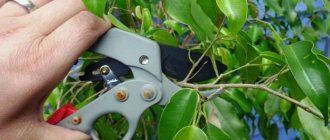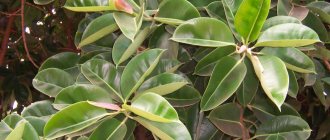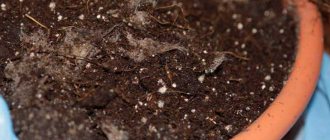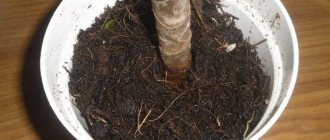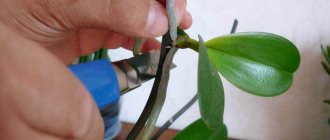Ficus is one of the few house plants that can be found in almost every living space. This popularity is due to its attractive appearance, as well as ease of care. In addition, there is a belief that ficus promotes family well-being, as well as the birth of children in the family. If you saw someone's gorgeous ficus Benjamin while visiting, you will definitely want to grow something similar at home, which is why you need to know how to plant a ficus shoot.
Rules to help you choose a healthy shoot
If you want to independently separate a shoot from a ficus, then you need to choose only strong and healthy plants, for example, you can take a cutting when cutting the crown of an adult ficus. However, before doing this, you need to make sure that the selected branch has leaves. The length of the process should be at least 10-15 centimeters. All actions must be performed with a sharp knife or blade. The cut must be made at an oblique angle. And under no circumstances should you use scissors, much less break a twig, as you will only injure the plant, which will result in delayed rooting and further development.
If you have chosen a large-leaved species for cultivation, then in order to grow a flower at home, it is enough for the cuttings to have 3-4 leaves. In this case, it is advisable to trim the lower one, since a large number of leaves will contribute to excessive evaporation of moisture. When growing small-leaved ficus, the lower leaves also need to be trimmed, but their number can be more than 3-4.
After the procedure of trimming the leaves and the shoot itself, the plant can release white sap. If you don't wash it with water, it dries out very quickly. This cannot be allowed. Therefore, after the shoot is cut, the juice should be washed off with warm water or placed in a container with water for several hours. It is also recommended to treat the cut area with charcoal.
Before planting a ficus shoot, you need to dry it or simply change the water several times. There are two methods of planting: cuttings from roots and without them.
Growing ficus using a leaf
If everything is clear with layering, then we should move on to the topic of growing a flower from a leaf. This is not a particularly complicated method, so it is worth paying attention to. First you need to cut the leaf with a small piece of the stem. The cut is made directly above the kidney; it should be straight and clear. If we are talking about the lower cut, then everything is the other way around - the cut should be oblique, and it is made in the lower part of the internode, located directly under the leaf plate that is being cut.
After the procedure, the cuttings are washed well under running water. The leaf must be twisted and tied with a string. During planting, the stem under the leaf blade must be sprinkled with substrate and supported. It is best to grow the plant in a greenhouse, which was discussed above. When young leaves begin to appear, the greenhouse is removed.
How to root a shoot correctly
Previously, it was said how to properly separate a shoot from an adult plant so that the ficus grows healthy. But this is not enough. It is also necessary to properly root the prepared cuttings into the ground. However, there are ways that will tell you how to plant a ficus shoot without roots.
The cutting should be planted immediately after it is separated from the adult plant. To do this, you need to prepare a mini-greenhouse, which should have good lighting, and also purchase some fertilizer. Plant the stem in the prepared soil, then cover it with a glass jar or cut plastic bottle. During the rooting period, the plant must be looked after. Care consists of regular watering and ventilation of the plant. Within 2-3 weeks the first leaf will appear, which is direct evidence that the cutting has taken root. Then you don’t have to replant it.
Is it possible to plant shoots without roots?
Ficus cuttings can be placed in the ground without prior germination. It is enough just to remove the milky juice by keeping the cut in water for 2-3 hours. Several blanks are placed in a loose substrate and a greenhouse is built over them.
For proper rooting it is necessary to ensure:
- moderate humidity;
- temperature not lower than 25°C;
- bright but not scorching lighting.
New shoots on the cuttings will appear in 35-45 days. During this period, the greenhouse begins to be opened and then removed completely.
How to choose a pot for a plant
The choice of pot is one of the important factors, since if you choose the wrong shape and volume, in particular, the ficus will not be able to fully develop. Therefore, before planting a ficus shoot, it is recommended to make a choice based on the size and degree of development of the roots. The container should not be too large; to plant a shoot, it is better to take a pot with a diameter of no more than 10 centimeters, and you need to make sure that there are drainage holes at the bottom. If there are none, then you need to make them yourself. The height of the pot should not be small; the roots should be at least 2 centimeters higher from the walls and bottom of the vessel.
Care after rooting
The formation of a root system on cuttings or layering is the first stage in obtaining a new specimen of ficus Benjamin. For the plant to grow stronger, it needs to be provided with comfortable conditions and quality care:
- Bright but diffused light. From a lack of sunlight, the ficus begins to stretch, weaken, losing the beauty inherent in nature.
- Temperature + 25-28°C and 16-18°C in winter. Keeping the ficus warm during the dormant period also reduces immunity and slows down the growth of new shoots.
- Humidity level not less than 60%. The moisture content in the air is regulated by installing automatic humidifiers, open water containers, and artificial fountains. During the heating period, the ficus pot can be placed on a tray filled with expanded clay and filled with water.
Step-by-step instruction
The best time to plant a ficus shoot is spring; summer sunny weather is better for rooting and subsequent adaptation of the plant. If the shoot is planted in the fall, the young plant will not have time to prepare for winter frosts and may simply die.
Before planting a ficus benjamina shoot, you need to select a cutting 10 centimeters long, which has previously been rooted into the ground. Further, all actions occur in several stages:
- Prepare all the necessary materials described earlier.
- Place drainage at the bottom of the pot to avoid excess moisture in the soil, since a large amount of water can lead to rotting of the roots.
- Fill the pot with the prepared earthen mixture, then make a small depression in the center, about one and a half to two centimeters high.
- Place the rooted cuttings in this hole and sprinkle a little with the mixture, then water generously.
Now the ficus can be placed on a windowsill or a special flower shelf, and the plant also needs special care to keep it healthy.
Ficus benjamina propagation time
Ficus benjamina is best propagated between April and June. At this time, the roots and leaves of the flower grow most actively, and the young plant obtained as a result of reproduction will be able to gain strength and grow before the onset of autumn.
Important! For successful propagation of Ficus Benjamin, the mother plant must be absolutely healthy.
For the propagation process to be completed successfully, the room with the ficus must be warm and light. Proper watering of the plant and high air humidity also play an important role.
Ways to stimulate rapid growth and root formation
After planting the rooted shoot in a pot, roots are formed in the callus tissue of the plants. This happens through mechanical damage to the stem, as a result of which the root system of the ficus is formed. To speed up this process, you can make a few small cuts on the stem yourself before planting the shoot.
Better growth of ficus is facilitated by the use of special chemical fertilizers. They will improve the formation of the ficus root system. Treatment with growth stimulants is carried out as follows: the shoots are soaked in the prepared solution before planting, or the cut of the cutting is treated with a preparation that comes in powder form.
What kind of soil does it like?
Ficus Benjamin is quite demanding on the composition of the substrate. Particular care must be taken in selecting soil for germinating cuttings and planting young plants.
Basic soil requirements:
- looseness;
- air and water permeability;
- nutritional value;
- neutral or minimal acidity.
The ideal composition for planting is special store-bought soil with the addition of coarse river sand. If it is not possible to purchase a ready-made substrate, it is mixed independently from the following components:
For young plants, all substrate components are mixed in equal proportions. To reduce acidity, a small amount of wood ash is added to the mixture.
Features of caring for cuttings
After you have successfully planted a ficus shoot, the plant will require careful care, in particular, it needs to be sprayed with water at room temperature every day, especially if the apartment is heated. It is better to place the pot with the plant in a bright place, since the leaves will be better colored in this case, but the light should be indirect.
Knowing how to properly plant a ficus shoot is not enough without knowledge about care. Watering with soft warm water is required twice a week. Before each subsequent watering, you need to make sure that the soil is slightly dry, since excess moisture can lead to rotting of the roots, and also because the leaves will fall off. The roots themselves should not be allowed to be in water, but there should also not be a lack of moisture, since the protective reaction in this case would be to completely get rid of the leaves.
If you plant three ficus shoots in a pot, then as they grow, you can give them a rather attractive shape, for example, braid several young plants at once. You can force the ficus to branch in the direction you want; to do this, just use a soft wire and tie the stem to it.
When growing, remember that ficus benjamina can be affected by mealybugs and scale insects. However, the biggest problem remains leaf fall, which can occur due to lack of moisture and moisture, as well as as a natural process as it matures.
If you pay due attention to the ficus, then in just a few years ficus Benjamin will grow on your windowsill, which you can give to any shape.
Reproduction methods
How does ficus "Benjamina" propagate at home? Like most members of the family, ficus "Benjamina" can be propagated in the following ways:
By cuttings
From the top of the shoot, a cutting 15-17 centimeters in length is cut with a sharp knife. You need to cut the workpiece at an acute angle.
The best shoots are semi-lignified. Young, immature ones are not suitable.
Three sheets are left on the workpiece, the rest are removed. Shallow cuts are made on the cuttings to increase the rooting surface.
The next stage is getting rid of the milky juice. It quickly hardens and clogs the cut, through which the roots will not break through.
To prevent this from happening, the cuttings are placed in water and kept there for about 8 hours.
The water is changed every two to three hours. Then the workpiece is removed and dried.
The cut is treated with a composition to stimulate root formation.
Rooting should be carried out in a container with a layer of damp cotton wool on the bottom.
You can do this in warm water, but with this method there is a risk of rotting of the cuttings. To prevent this, you can add a little charcoal to the water.
Keep the planted workpiece in a lighted place, but keep it out of the sun - the cutting will wither in such conditions.
After 10-14 days you will see white roots emerging. Now the shoots of the ficus "Benjamina" can be planted in the soil.
The composition for planting cuttings with roots is as follows: leaf soil, peat, sand in equal parts.
You can root the cuttings in the soil substrate.
After removing the juice and drying, the workpiece is immersed in peat or in special soil for cacti for 2 buds , roots will appear near them.
For germination, it is necessary to create greenhouse conditions by covering the pot with a transparent cap.
The planting is ventilated so that the bottom of the workpiece does not rot. The substrate must be warm, it is advisable to warm it up artificially.
After 1.5-2 months, small leaves will appear on the workpiece. This indicates that the cutting has taken root.
But don't rush to open it. You need to accustom the sprout to air gradually, opening the greenhouse for more than a few hours a day.
By layering
The fastest way to obtain a full-fledged specimen with a height of 50-60 centimeters in a few months.
Layers are grown on the trunk of the ficus "Benjamina". From an area of 10-15 centimeters, located 60-70 centimeters below the crown, all leaves are cut off and the bark is cut out in a ring shape.
The cleaned area is moistened with root or heteroauxin, wrapped in moistened sphagnum moss and transparent plastic film.
The structure is fixed with wire or tape. To maintain moisture, use a syringe to add a little liquid under the film.
After 35-50 days, a powerful root system is formed on the trunk. The cuttings are cut from the main stem and planted in a separate pot.
At the same time, the growth of lateral shoots begins on the mother ficus, and it also does not lose its decorative effect.
From seeds
How to propagate ficus "Benjamina" at home from seeds?
This is the longest and most labor-intensive process. But flower growers claim that it is precisely this that will allow them to obtain the strongest, most viable and especially ornamental plant.
Ficus seeds do not ripen at home, since pollination does not occur indoors. Seeds must be purchased in specialty stores.
Before purchasing, make sure that the storage conditions for the goods are observed at the point of sale.
Ficus seeds are sensitive to changes in temperature and air humidity. There is a risk of purchasing material that is not suitable for planting.
Purchased seeds are disinfected in a weak solution of potassium permanganate and soaked for an hour in a growth stimulator.
Place drainage in a 2 cm , and pour soil on top of it.
The substrate for sowing is sterilized with steam for an hour.
Ready-made soil for ficus trees or a mixture of peat, sand and deciduous turf is suitable(1:1:1).
Moisten the soil before planting; this can be done by submersion.
A layer of soil 10-12 centimeters high is poured into a flat dish
The height of the soil should be 4-5 cm below the edge of the container.
Lightly tamp the substrate without compacting it too much, this will cause moisture stagnation.
Distribute the seeds evenly over the surface. They are very small, so use tweezers or the moistened tip of a stick to which the seed is glued to transfer it to the ground.
Sprinkle the seeds with a five millimeter layer of soil and moisten with a spray bottle.
Advice: when further moistening the crops, do not use a watering can - jets of water will wash away the soil and they will die. Moisturize by spraying.
The container is covered with glass or film and placed in a warm and bright place for germination.
Important: do not expose the dishes to direct sunlight - the seeds will die from overheating.
The best time for sowing is spring, when there is enough light. If ficus is sowed in autumn or winter, the seedlings will stretch out due to lack of light.
Glass from the dishes during the germination process is periodically (about twice a day for 10-15 minutes) removed for ventilation.
As soon as the seedlings appear, they must be hardened by removing the glass and leaving them in the open air for a short time at first. Gradually the time is increased.
After about a month and a half, the first true leaf appears at the seedlings. But don’t rush to pick up the sprouts right away. Do this after 3 months.
Make sure that the seedlings have enough light, otherwise they will become elongated and frail.
Important: when picking, make sure that the root collar does not go deep into the soil; it should remain at the same level as during germination. Ficus sprouts are planted in a separate pot when they reach a height of 10-15 cm.
From a sheet
This method is only called sheet.
In fact, for propagation it is necessary to cut off part of the stem with one leaf.
Only from such a preparation can a full-fledged plant with a trunk be obtained.
It is a mistake to believe that you can grow a new ficus from a leaf that has fallen off by accident or from drying out.
The leaf stalk is cut with a sharp knife with a piece of shoot about 5-6 cm.
The cut must be slightly split and placed in a glass of water for a day to drain the milky juice.
Additionally, you need to make small cuts on the cuttings - roots will sprout from them. Then the workpiece is placed in a root former solution for another day.
Important: the procedures are carried out in warm water and an air temperature of at least 20 degrees , otherwise the sheet will rot.
The prepared sheet is rolled into a tube and secured with an elastic band. The cutting is placed in the prepared substrate to the base of the leaf.
Advice: to prevent it from falling under the weight of its own, place a support stick next to it.
The planting is covered with a transparent cap to create greenhouse conditions and placed in a warm, well-lit place.
In about a month, a young ficus leaf will appear from the ground, this means that rooting has occurred successfully.
By following the rules of propagation, you will receive beautiful specimens of ficus “Benjamina” for interior decoration.
Origin story
The homeland of ficus benjamina (subgenus Urostigma) is considered to be India, the countries of Southeast Asia, and the Philippines.
Under natural conditions, this evergreen (there are deciduous species) plant reaches a height of 20 meters , is very hardy, and is not afraid of temperature changes, winds, or heavy rains.
But as an ornamental tree, it is more delicate, whimsical and requires serious care.
Benjamin can begin its development both as an ordinary tree and as an epiphyte, the roots of which, after a certain period of time, reach the soil and take root, giving life to several shoots.
Gray smooth bark with thin streaks, a wide crown and thin shoots with drooping leaves.
the fruits , which are called syconia, but if your ficus has bloomed, then paired fruits will soon appear on it, tightly adjacent to the shoots, which grow up to 2 cm , when ripe, they become burgundy and inedible.
Are you interested in growing ficus trees at home? Read about the features of care and cultivation of such varieties: Ginseng, Retuza, Amstel King, Triangular, Dwarf, Karika, Lirata, Ali, Pumila White Sunny and Eden.
Diseases and pests
Ficus trees are very disease resistant. The most dangerous period for them is the first three months.
Among the pests that are dangerous for ficus are aphids, spider mites, and shield aphids.
Carefully and carefully wash the leaves with a soapy solution, to which you can add tobacco dust, chamomile, and calendula.
Wipe the leaves to remove insects. Do not forget to constantly spray the plants, this is the best prevention.
Are your ficus balsam leaves falling?
When overmoistened, a sudden change in temperature, or drafts, ficus plants lose leaves. Follow all the rules for growing and caring for this plant, do not allow the soil to become waterlogged or dry out to prevent this from happening.
But what if all the rules are followed and the leaves fall? Don't worry, sometimes this is a completely normal, natural process. For example, trees lose leaves on the lower part of the trunk, as in nature.


